Edward S. Ellis' first of the dime or penny magazine fictional stories that featured the "Steam Man" had a publish date of August 1868, some 7 months AFTER the first known announcement of Dederick's actual "Steam Man" in January 1868.
Note: There are those who have either mistaken or mis-represented the Ellis story date for 1865, to conveniently make "America's first Science Fiction" dime story predict or even inspired the building of Dederick's real one.
Here's the timeline of some of the published dime magazines with articles containing the various steam men, along with the steam horse, electric horse, and the electric man.
-1868 August- Fiction – in Edward S. Ellis' story "The Huge Hunter, or the Steam Man of the Prairies",
Johnny Brainerd builds a Steam Man.
Here's all the known reprints (from Wiki). The original novel was reprinted six times from 1868 to 1904. The only known copy of the first 1868 printing with its cover intact is owned by the Rosenbach Museum and Library, Philadelphia.
[edit] References
Beadle's American Novel No. 45, August 1868, featuring "The Steam Man of the Prairies" by Edward S. Ellis.
Beadle's Half Dime Library Vol. 11 No. 271, October 3, 1882, featuring "The Huge Hunter; or, The Steam Man of the Prairies" by Edward S. Ellis.
Frank Starr's American Novels No. 14, 1869, featuring "The Huge Hunter; or, The Steam Man of the Prairies"
1876 – Fiction – in [Harry Enton] Harold Cohen's (penname) story "Frank Reade and His Steam Man of the Plains, or, The Terror of the West",
Frank Reade builds the Steam Man MkII.] – RH 2010 – I find it interesting that Enton's name is spelt "Entom" in the article, and that the Reade's name is spelt "Reed", which is different to that on the illustration on the same page.
Beadle’s Pocket Novels No. 40, January 4, 1876, featuring "The Huge Hunter; or, The Steam Man of the Prairies" by Edward S. Ellis.
1882 – Fiction – in [Harry Enton] Harold Cohen's (penname) story "The Steam Man of the Plains, or, The Terror of the West", Frank Tousey's Boys Weekly Vol. I. No. 24. May 19, 1882.
Frank Reade builds the Steam Man MkII.]
Beadle's New Dime Novels No. 591, January 27, 1885, featuring "The Huge Hunter; or, The Steam Man of the Prairies" by Edward S. Ellis.
Pocket Library No. 245, September 19, 1888, featuring "Baldy's Boy Partner; or, Young Brainerd's Steam Man" by Edward S. Ellis.
Beadle's Half Dime Library No. 1156, December 1904, featuring "The Huge Hunter; or, The Steam Man of the Prairies" by Edward S. Ellis.
[1879 – Fiction – in Luis Senarens's story "Frank Reade Jr. and His Steam Wonder",
Frank Reade Jr. builds the Steam Man MkIII.]
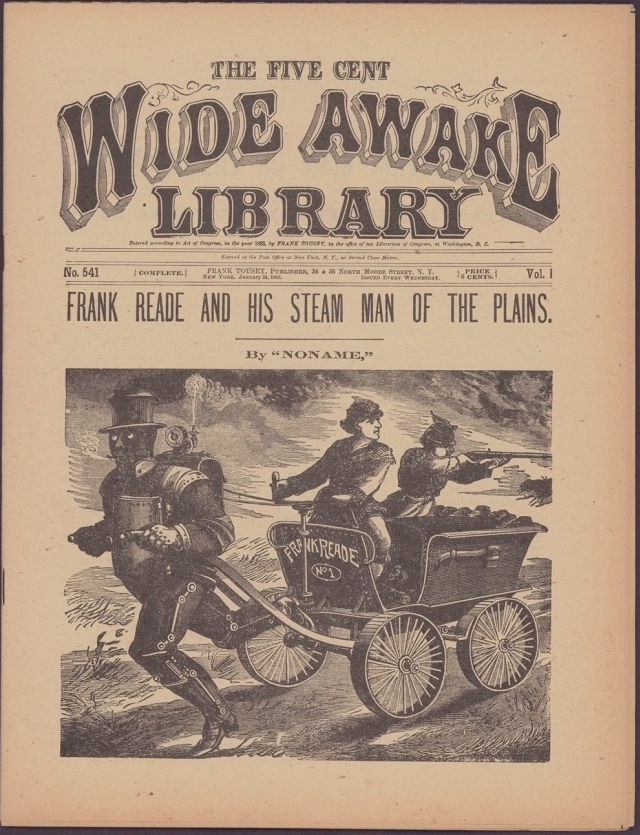
1883 – Frank Reade and His Steam Man of the Plains; or, The terror of the West. By "No name." In The Five Cent Wide Awake Library. Vol. I. 541. January 24, 1883. The Dime Novel Club; facsimile reprint no. 6. (Senarens, Lu)
[1885 – Fiction – in Luis Senarens's story "The electric man, or, Frank Reade, Jr. in Australia",
Frank Reade Jr. uses an Electric Man.]
Steam Horse dates:
Frank Reade and His Steam Horse. By "No name." In Frank Tousey's Boys Weekly. Vol. II, No. 44. October 6, 1882.
Frank Reade and his steam horse. By "No name." In The Five Cent Wide Awake Library. Vol. I, No. 553. April 18, 1883. The Dime Novel Club; facsimile reprint 6A.(Senarens, Lu)
1892 – Frank Reade Library, No. 8, November 12, 1892. Title,"Frank Reade, Jr., With His New Steam Horse Among the Cowboys: or, The League of the Plains," by "Noname".
Electric Horse
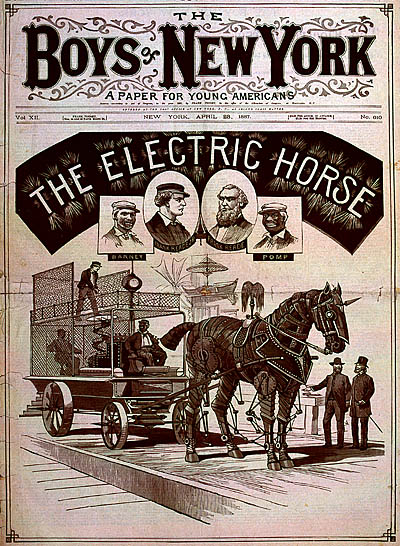
In Boys of New York(April 23, 1887), Frank Jr. invents an "Electric Horse" to hunt for lost treasure in Peru. The horse has electronic torpedoes for blasting, gun rifles on either side, and travels up to thirty-five miles per hour. Accompanying Reade on his journey are Barney and Pomp, two servants who help operate the weapons by firing on those who interfere with Reade's treasure hunt.
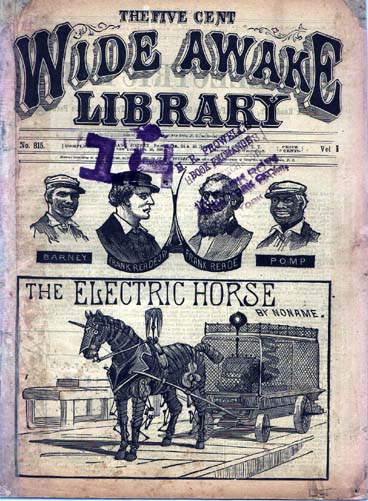
The Five Cent Wide Awake Library. Vol. I No. 815 1888. The Electric Horse By Noname. 32pgs.
A little information on the Electric Horse. [sourced from
here.]
The Boys’ Champion. ( 1881-1883) No. 17 and 18 The Electric Horse; Or, The Demon Of The Plains. By Fred Hazel.
No. 30 and 31 The Flying Marvel : Or, The Emperor Of The Air. Fred Hazel. By the author of Nobody’s Child, Lotta, the Young Lady Detective, The Electric Circle, and Lost In Cloudland.
The mysterious “something” that Ike Anderson is building in his parlor is the talk of the town. After the death of his father a German American boy, Bob Stump, comes to live with Ike and his sister, Maggie. Ike shows him the secret of his “something.” “By shiminy Christmas! It is made of iron isn’t it ?” asks Bob. “It is a horse,” said Ingenious Ike, slowly and with emphasis, “It is an Electric Horse!”
A description follows:
“During this time the wooden skeleton of a horse had been completely enclosed by plates of iron- or, more properly steel- shaped so as to conform to the out-line of a well-formed horse.
The upper edge of each plate was tucked up under the lower edge of the plate above it, and ingeniously riveted together, and by the joining together of many plates, the horse was formed.
Then the wooden frame-work or skeleton was removed from the interior.
The horse was a giant in stature, and Bob could walk right under his belly without scraping his head even if he stood on tip-toes.
In the horse’s belly was an iron flap or door, which, on touching a hidden spring, dropped down, leaving a sort of door up through which a person could climb into the interior of the body.”
Two powerful electric batteries, connected to wires, and magnets powered the Electric Horse. Now it was time to put it to the test:
“Ike touched a spring in the horse‘s belly, and the moveable plate falling, left an opening into the body, from which a short rope ladder fell simultaneously with the moving of the plate.
Up into the body Ike went.”
After a successful test, Ike and Bob pack food, guns and ammo. “Then one night, just after the clock had struck the hour of twelve- Ike- climbing inside the Demon caused it to advance toward the door.”
The hired man wakes up and flees at the awesome sight, while Bob and Ike say their tearful farewells to Maggie.
“A couple of minutes later the road was reached, and as Ike turned the electric steed’s head away from his home he muttered:
“Off for the plains!”
The story was not earth-shaking, but was a good read, and, as far as I know The Electric Horse never returned. Enton’s Steam Man was much better written, and the plot is a blueprint for The Electric Horse. In Volume One No. 28 of The Boys of New York (1875-1894) was the first installment of Harry Enton’s serial, The Steam Man of the Plains; or, The Terror of the West (1876), inspired by Beadle’s Steam Man of the Prairies by Edward S. Ellis which appeared in Irwin’s American Novels #45 in 1865 at the end of the Civil War. (I would like to know if this one was advertised and reviewed in Frank Leslie's Illustrated Newspaper.)
From The Steam Man of the Plains; or, The Terror of the West, in Boys' of New York:
‘Charley Gorse beheld a metallic imitation of a man. The figure was about twelve feet high from the bottom of the huge feet to the top of the plug hat which adorned the steam-man’s head. An enormous belly was required to accommodate the boiler and steam chest, and this corpulency agreed well with the height of the metallic steam chap. To give full working room to the very delicate machinery in the interior, the old giant was made to convey a sort of knapsack upon his shoulders. The machine held in it’s arms in the position taken by a man when he is drawing a carriage.
Charlie glanced up at the face of the monster and beheld a huge pair of glass eyes and an enormous mouth.
“Now then,” said Frank, “the lamp will be in his head, and his eyes will be the headlights. His mouth holds the steam whistle. Here, in his belly, we open a door and put in fuel, and the ashes drop down into his legs and are emptied from the moveable kneepan, and without injury to the oiled leg-shafts, for they are inclosed in a tube. That is why the fellow’s limbs are so large. These wire cords increase the power in one leg, and cause that leg to go much faster, and in that manner we get a side movement and can turn around.
“Go on,” said Charlie, who was intensely excited. “It’s feet are spiked like a baseball player’s are spiked, to prevent the machine from slipping under speed,” said Frank. “Then you notice that it’s legs are very long, and very far apart, so as to give it balance. This stop-cock on the side will let on or shut off steam.”
Frank returned in No. 48 in Frank Reade and His Steam Horse.
Hazel’s stories seemed to be written for younger readers of 12 to 15 years of age. I don't have any bio on Fred Hazel but it could be in Randolph J. Cox Dime Novel companion: A Source Book.Maybe you can find something in here for your website ( which is a good one.) The Boys' Champion also published The Champion Library which was pocket sized.There was also a Boys' Champion Story Paper published in London by James Henderson and Sons in 1901. I'll have more on The Boys' Champion in the future. It was quite similar in style to Munro's Boys' of New York, and used some of the same authors.
John.
—
also
There was a third SF series in the dime stories, in Leon Lewis' The Boy's Champion (1881 to 1883,) of New York. These were tales of The Electric Horse, and featured Ike Anderson, as the boy inventor. The writer was Fred Hazel, probably a nom de plume, and closely copied Frank Reade's Adventures. Harry Enton wrote the final serial for The Boys' Champion featuring a boxer, Young Sullivan.
John.
——————————-
Fictional Victorian Steam and Electric Men
The following were, no doubt, inspired in the first place by Zadoc P. Dederick's Steam Man announced to the public at least as early as January 1868.
1868 – John Brainerd's The Steam Man – fiction
Johnny Brainerd was the creation of Edward S. Ellis in "The Huge Hunter, or the Steam Man of the Prairies", which first appeared in Irwin P. Beadle's American Novels #45 (August, 1868) before being turned into a novel and reprinted many times over e.g. Frank Starr's American Novel No. 14, in 1869, then reprinted in Beadle's New Dime Novel No. 591, in 1870, and was reprinted three more times in Beadle libraries from 1882 and up. [RH-2010- note similar wording to 1933 article below.]
In the story Johnny Brainerd, a small, hunch-backed dwarf, on his mothers suggestion builds the Steam Man, ten feet high with a stove-pipe hat, which tows behind it a wagon in which Johnny Brainerd and any passengers ride and which carries the wood to feed the Steam Man. After building up a full head of steam it's capable of moving 30 miles an hour.
Fantastic, Mysterious, and Adventurous Victoriana by Jess Nevins
http://www.geocities.com/jessnevins/vicb.html [Aug07]
1876 – Frank Reade's The Steam Man MkII – fiction
1879 – Frank Reade Jr.'s The Steam Man MkIII – fiction
Frank Reade was created by "Noname," aka "Harry Enton," aka Harold Cohen, and debuted in “Frank Reade and His Steam Man of the Plains, or, The Terror of the West”, Boys of New York #28, 28 February 1876.
Later Luis Senarens created Frank Reade Jr. in the story, "Frank Reade Jr. and His Steam Wonder" (Boys of New York #338-350, 4 February-29 April 1879) and much later, in 1899, Frank Jr. was succeeded by Young Frank Reade.
Frank Reade's Steam Man is much like that of Johnny Brainerd, only it has headlights. Better still, it is armed, shooting "fiery missiles" which dart "hither and thither like stars of fire" from "belts of fire at the neck and waist" of the Steam Man, its wagon is not covered and is two feet taller and can travel at a staggering 50 miles per hour.
Fantastic, Mysterious, and Adventurous Victoriana by Jess Nevins
http://www.geocities.com/jessnevins/vicr.html [Aug07]
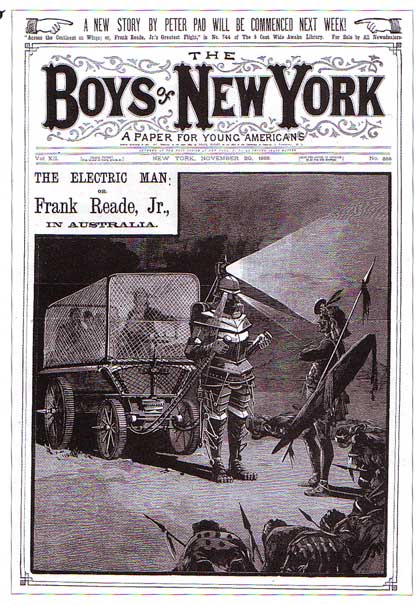
1885 – Frank Reade Jr.'s The Electric Man – fiction
Nevins doesn't mention the Electric Man however Luis Senarens using the pseudonym "Noname" wrote the story "The electric man, or, Frank Reade, Jr. in Australia" which was published by Frank Tousey, 1893. (Frank Reade library ; no. 37, v. 2). A copy is in the University of South Florida Library
http://www.lib.usf.edu/ [Aug07]
[The electric man may have debuted in earlier Frank Reade stories.]
1892- Frank Reade, Jr., With His New Steam Man in Texas: or, Chasing the Trainrobbers," by "Noname" – Frank Reade Library, No. 4, October 15, 1892.
1893 – Professor Archibald Campion's Boilerplate – fiction
This is entirely a 21st century creation of Paul Guinan & Anina Bennett on their Big Red Hair site
http://www.bigredhair.com/boilerplate/index.html and only mentioned in error by Nevins (see above 1865 – John Brainerd's The Steam Man).
—————

Frank Tousey – Frank Reade Library (images of steam man v2 and steam horse in title) Frank Reade, Jr.,, And His New Steam Man; or, the Young Inventor's Trip to the Far West. by "Noname". Vol I No. 1 "Noname." Frank Reade, Jr. and His New Steam Man. Frank Reade Library, 1, September 24, 1892.
"Frank Reade, Jr., and his New Steam Man; or, The Young Inventor's Trip to the Far West." Frank Reade Library, Vol. I, No. 1. New York: Frank Tousey, 24 Sept. 1892.
Interesting article of 1933 where the author had the same problem as we re-encountered recently in trying to determine who wrote the first "Steam Man" dime story.
Blood and Thunder – February 1933
BEADLE HAD A STEAM MAN, TOO
BY CHARLES BRAGIN
In looking over back numbers of BLOOD AND THUNDER and other dime novel papers, I noticed some controversy and doubt as to the originator of the Frank Reade stories. This puzzles me, because the first four stories, of Frank Reade, Sr., have the name Harry Enton shown in-them as author. The early Wide Awake Library lists on back of Tousey publications, also have Enton's name printed as author of these stories. Ditto with the originals in Boys of New York.
Lu Senarens is credited with all the Frank Reade, Jr., stories, as well as the Jack Wright stories, but this is all wrong. He wrote MOST of these stories— all the F. R., Jr., originals in the F. R. Library and the reprints in the F. R. Weekly Magazine, but most of the stories in Boys of New York were NOT written by him. He probably wrote ALL the stories of Reade and Wright in Happy Days.
I have very good reasons for believing that not only Enton and Senarens, but other Tousey writers took a "fling" at the stories—particularly those published in Boys of New York. –
Something not generally known is the very interesting fact that Beadle published a ''Steam Man" story. As it was written by Ellis, it was a good one. "The Huge Hunter ; or The Steam Man of the Plains," in Beadle's Half Dime Library', No. 271. Published in 1882, six years after the original Steam Man appeared in Boys of New York.
This would seem to indicate that Enton was the first to produce a Steam Man story, but such is not the case. Ellis was the originator of the Steam Man. His story appeared in Frank Starr's American Novel No. 14, in 1869, then reprinted in Beadle's New Dime Novel No. 591, in 1870, and was reprinted three more times in Beadle libraries from 1882 up.
The Beadle Steam Man, like the story itself, was far superior to the Tousey article. Not that it was a more wonderful performer—quite the opposite, it was a rather crude product, compared with the Enton "Invention"—but its very CRUDITY made it more plausible. Enton's was too perfect to be true
Also, Ellis in his story, devotes considerable space to the description of the difficulties experienced in getting his Steam Man to work properly—gives detailed data on its construction.
The illustration of the Beadle Steam mas is likewise very crude ; a junky sort of machine, but it is again a PLAUSIBLE article—as one would expect a machine to look after being built by a boy "by hand." And the illustration, crude as it is, clearly shows how the Steam Man operates.
(To be Concluded)
Blood and Thunder – March 1933
BEADLE HAD A STEAM MAN, TOO
BY CHARLES BRAGIN
PART TWO
The Tousey Steam Man could not run Or move in a million years, if built as the pictures reveal "him." And the author's written description is just as unsatisfactory, as is the case with practically all of the Reade and Wright "inventions"—not only are they impractical, but show that the authors had little knowledge of even ordinary mechanical workings. Of course, their boy readers knew even less, so it sounded all right to us, when we used to read them "back when."
There have been hundreds of Tousey, Munro and Street & Smith invention stories published, but only ONE Beadle Steam Man story—so it might be worth while to reprint it in BLOOD AND THUNDER as a "rarity." Of course, balloon stories have been published in Beadles, but these are not considered invention stories.
(THE END)
( The Steam House," by Jules Verne, is a story of a Steam Elephant, which appeared serially in The Union Jack, a boys' paper published in England. The story started in No. 41, Oct. 7, 1880 and ended in No. 76, June 6, 1881. Pub.)
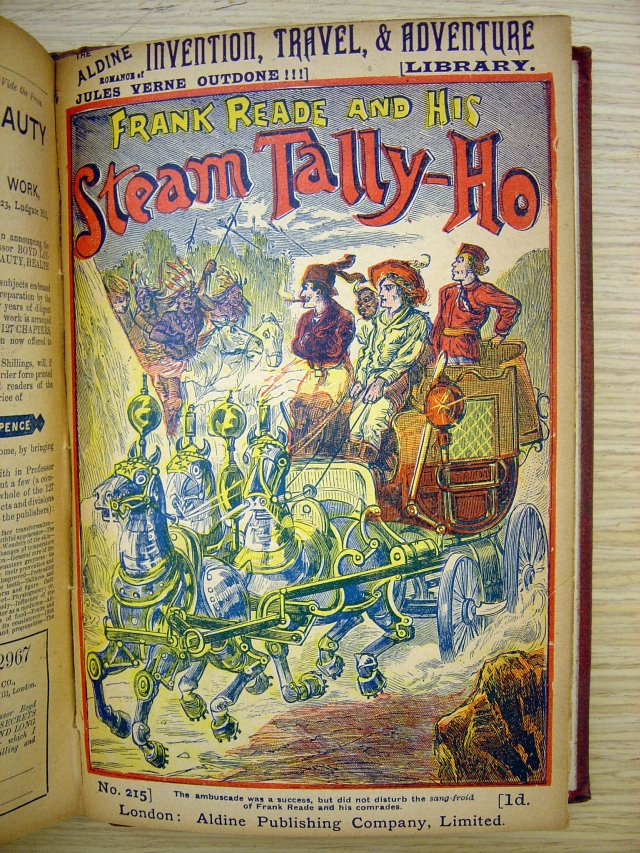



Aldine Colour Covers supplied courtesy Joe Rainone.

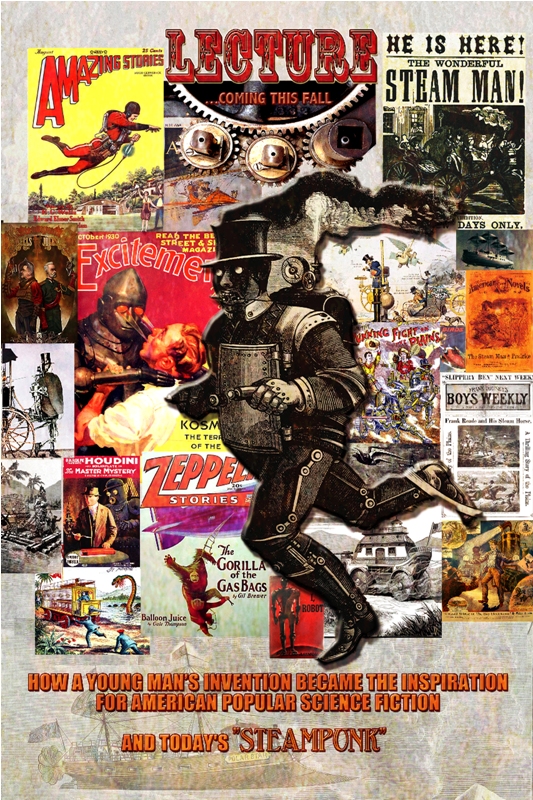
Joe Rainone recently conducted a lecture on Popular Culture and the Steam Man – here is his poster for that event.
Credits: My original collection was not intended to be published, so I did not keep references for all my items, nor do I have the time to 'find' them again. I'm more than happy to acknowledge those who recognise their work.
For more recent finds I now do keep references.
see http://magazinehistory.blogspot.com/2010/01/origins-of-american-science-fiction.html for some text and rare images of the Steam Man.
Also extracts from here.


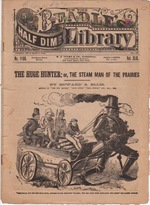

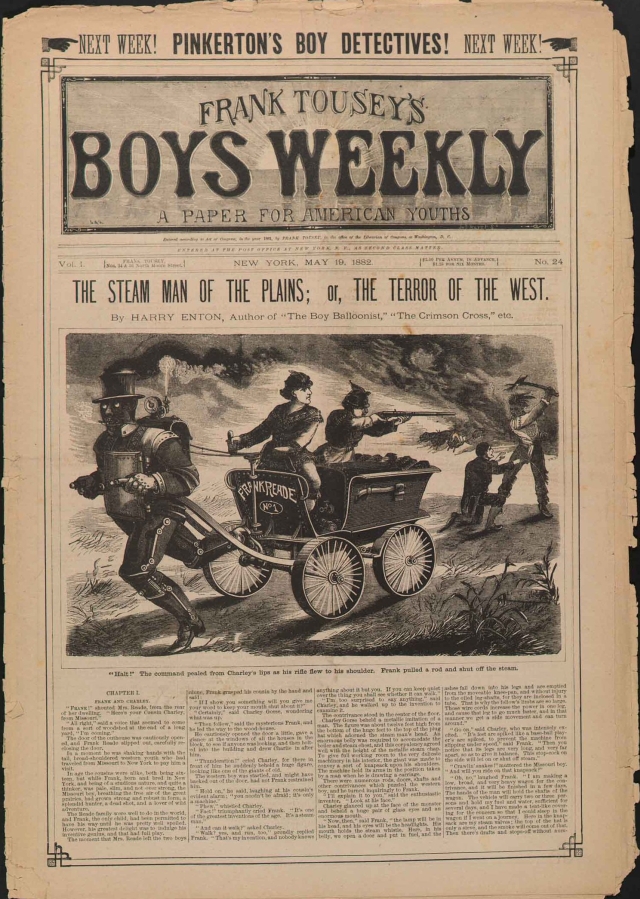


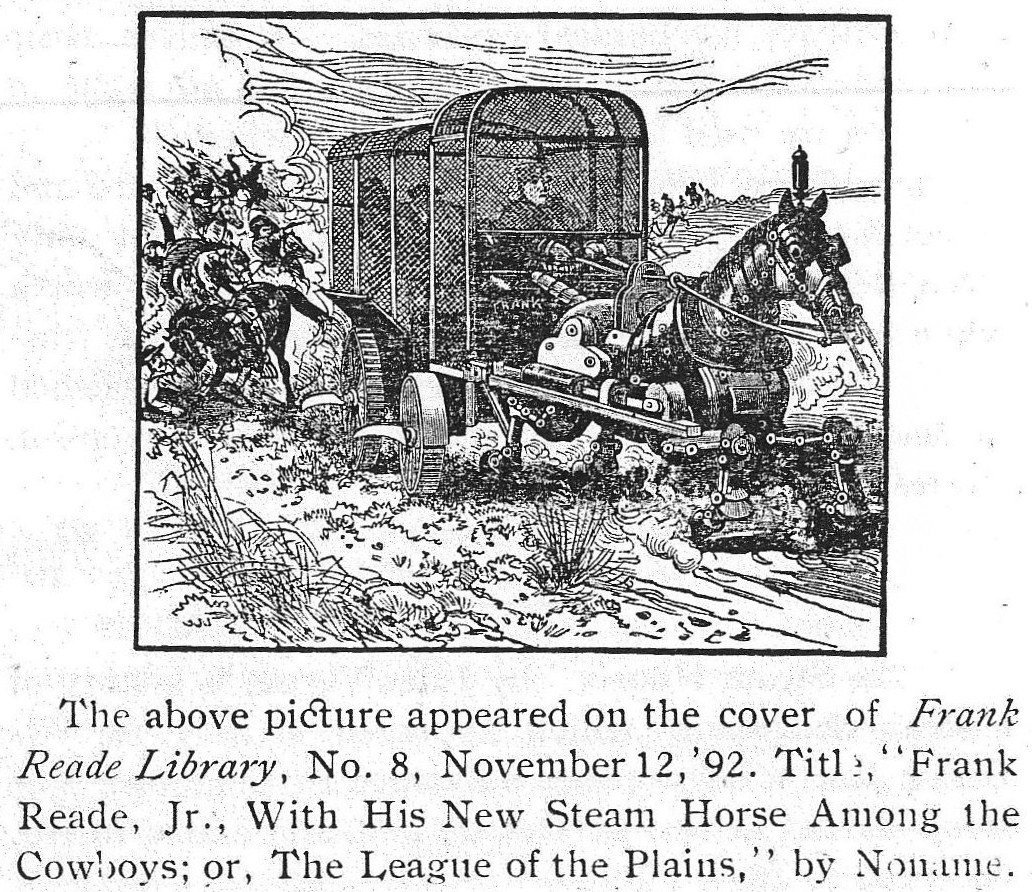











In this vein you may be interested in my novel series The Steam Man of the West, available from Amazon and as an ebook everywhere. Thanks.